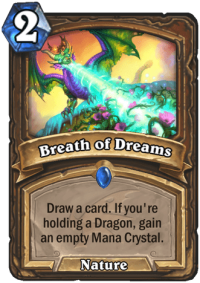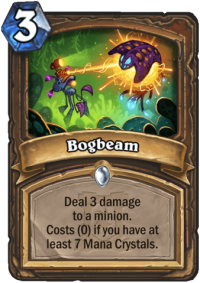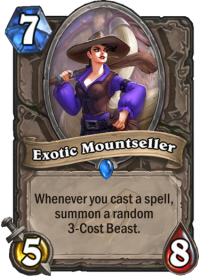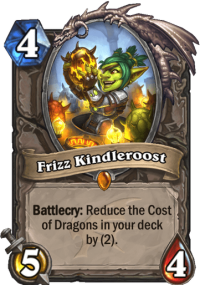Our Big Druid deck list guide for the Ashes of Outland expansion features one of the top lists for this archetype. This Druid guide includes Mulligan Strategy, Gameplay Tips, Card Substitutions, and Combos/Synergies!
Introduction
It was only a matter of time until the emergence of a ramp-based Druid archetype with the arrival of Breath of Dreams and Overgrowth to replenish the class’ diminished evergreen tools. This, coupled with Strength in Numbers and some other tools printed in the new set, enabled what’s perhaps the most “single-minded” iteration of the archetype which revolves around skipping the first few turns in order to gain enough mana so that they can turn the tables with massive minions played on unexpectedly early turns.
Though the early and massive flow of threats will set you up well against any slow deck, the real challenge of any such archetype is to stay alive long enough until aggressive opposition to find a spot to stabilize and eventually turn things around. Despite Demon Hunter remaining a huge part of the metagame, Big Druid was strong enough for a Legend 1 climb by 莫论人非 using the build we’ve featured below.
Big Druid Deck List
This is one of the best decks for Big Druid in Ashes of Outland. The deck list might still get changed or refined – if it happens, we’ll update it here!
- 0Big Druid Deck List Guide – Ashes of Outland – April 20201
- 0Big Druid Deck List Guide – Ashes of Outland – April 20202
- 0Big Druid Deck List Guide – Ashes of Outland – April 20202
- 0Big Druid Deck List Guide – Ashes of Outland – April 20202
- 1Crystal Power1

- 1Strength in Numbers2

- 2Breath of Dreams2

- 2Ironbark2

- 3Imprisoned Satyr2

- 4Overgrowth2

- 6Emerald Explorer2

- 7Winged Guardian2

Find more versions of this deck type on our Big Druid archetype page!
Mulligan Guide and Strategy
Higher Priority (Keep every time)

- Breath of Dreams – Ah yes, Wild Growth on steroids can finally fulfill its intended use. It’s a straightforward mulligan choice in a ramp deck: just make sure to fish for a Dragon alongside it so that it doesn’t get stuck in your hand!
- Overgrowth – The other big mana
- Strength in Numbers – Much like in the case of Embiggen druid, the immediate casting of a bonus big minion in the mid-game can be a blowout move in most matchups. It’s also a straightforward way to spend your opening turn with this deck.
Lower Priority (Keep only if certain conditions are met)
- Imprisoned Satyr – This little fella can help smooth out your curve if you’re directly lacking ramp tools, but he’s only worth having around alongside the other mana cheating cards if you can smoothly slot him in without floating any resources. Not an altogether awful option either if you’ve blanked on your other ramp tools.
- Wrath – The cycle ability can be just as valuable as the early removal potential in this archetype, but it won’t be enough to get you out of trouble without one of the aforementioned ramp cards.
- Innervate – Though a useful tool to smooth out your curve, you should only consider keeping it in your opening hand if it’s there to bridge the gap between other permanent ramp tools. One mana this turn isn’t worth anywhere near as much as two for the rest of the game.
General Playstyle and Strategy
Vs Aggro

Take a deep breath, this is going to be a gauntlet for the ages. Ultimately, your win condition is to wall off your opponent with a set of taunts and quickly finish them off with your oversized minions before they can engineer some sort of burn-related finisher (or in the case of Demon Hunter, draw Kayn Sunfury). However, you can’t just take a million damage while you ramp up to play them out one by one. By the same token, stocking up on your limited removal options will inevitably leave you dry in the mid-game.
It’s a difficult and careful balance you need to find with Ramp Druid in the aggro matchups, and your most important consideration has to be protecting your health total. Zilliax is no longer in Standard and you only have Alexstrasza (a very expensive minion) and Crystal Power (a one-off tech choice) as potential heal options, making you very susceptible to burn. This means that you will often need to prioritize the removal of cheap enemy minions before you would ramp up. That innocuous-looking 3/2 your opponent just tossed out? Ramp up without a care in the world and it will deal nine damage to your face before you get to block its attack.
This makes the free minion summon from Strength in Numbers even more valuable than it normally is – and Ironbark serves as a wonderful insurance tool if your curve only happens to throw up non-ramp minions. This and Bogbeam means that seven mana is the critical point where you can start to turn things around – making as many value trades as needed to ensure you won’t die to burn or silence tools –, but it’s really your seemingly miniscule early-game decision palette which will decide whether you live or die by the end of the match. Protect your hit points more than you usually would and your winrate will greatly benefit from it.
Vs Control

Exhale. You’re safe. Hard-mulligan for ramp and you’re good to go. Even if you can’t rocket to eight mana in four turns, your opponents will not be able to put up enough pressure to stop you from getting to your big threats. Since they all have a lot of health, they will survive most of the smaller AoE tools at your enemies’ disposal. The real concern is to keep an eye out for specific high-impact removal spells (like Twisting Nether or Flik Skyshiv) and slowly roll out new threats accordingly. Don’t bother with value trades unless it’s absolutely necessary: though you do have a lot of threats, they are still limited in number, and you are playing the beatdown role in this matchup. Additionally, try to hold back your cheap spells for Exotic Mountseller as they otherwise offer little to no value in these matchups.
Card Replacements

The main consideration with Big Druid is how much payoff and consistency you want to sacrifice for your anti-aggro gameplan. Go overboard and you can’t apply enough pressure even when you do get to ramp safely – but an overly greedy player will just die before they can turn things around. The featured build leans quite heavily into the ramp approach, with Ironbark and Bogbeam doing some heavy lifting past turn 7, but if you feel like you’re getting VENGEANCEd way too often on the ladder, there are some quick fixes to consider.
Frizz Kindleroost is a popular option to smooth out your curve a bit and throwing in two copies of Swipe instead of the Imprisoned Satyrs can also ease the pressure. That said, note how Crystal Power is a much more efficient synergy tool with Exotic Mountseller, plus a very important (and rare) way to stabilize your health total against Demon Hunter!
Leave a Reply
You must be logged in to post a comment.





U cant win with this deck against rogue with stunner card and a good DH.. its pretty obvious ..the guy that made the deck went with rogue and dh decks on high legend and then played 3-4 games with this deck and prop won and he ran to post this on twitter.. THIS DECK SCKS..u basically lose every game early game
This deck is way too reliant on drawing a good starting hand – must have been a total fluke to get to #1 legend.